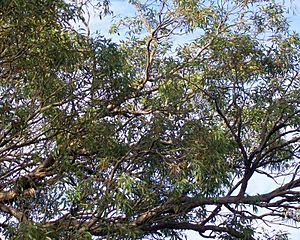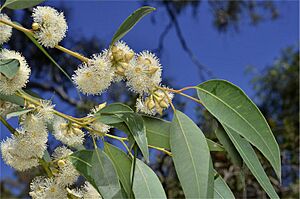Blue Mountains mahogany facts for kids
Quick facts for kids Blue Mountains mahogany |
|
|---|---|
 |
|
| Blue Mountains mahogany tree near Springwood in the Blue Mountains | |
| Scientific classification | |
| Genus: |
Eucalyptus
|
| Species: |
notabilis
|
The Eucalyptus notabilis, commonly known as Blue Mountains mahogany or mountain mahogany, is a special kind of tree found only in eastern Australia. It's usually a small to medium-sized tree. You can spot it by its rough, fibrous bark on its trunk and branches. Its leaves are shaped like a spear or slightly curved. When it flowers, you'll see groups of seven to eleven white flowers. After flowering, it produces fruit that looks like a half-sphere or a cone.
What Does the Blue Mountains Mahogany Look Like?
The Blue Mountains mahogany (Eucalyptus notabilis) is a tree that usually grows up to about 30 meters (about 98 feet) tall. It has bark that stays on the tree, which is rough, stringy, and grey to reddish-brown. This bark covers both the trunk and the branches.
Young plants and new shoots that grow from the base of the tree have dull green leaves. These leaves are paler on the underside and are about 70 to 130 millimeters (2.8 to 5.1 inches) long and 18 to 45 millimeters (0.7 to 1.8 inches) wide. They also have a small stem called a petiole.
Adult leaves are shiny green on the top and paler underneath. They are shaped like a spear or are slightly curved, measuring about 70 to 190 millimeters (2.8 to 7.5 inches) long and 15 to 33 millimeters (0.6 to 1.3 inches) wide. These leaves narrow down to a petiole that is 10 to 35 millimeters (0.4 to 1.4 inches) long.
The flower buds grow in groups of seven, nine, or eleven. They are found where the leaves meet the stem, on a stalk called a peduncle that is 5 to 15 millimeters (0.2 to 0.6 inches) long. Each individual bud might sit directly on the stalk (sessile) or have a tiny stem of its own called a pedicel, up to 5 millimeters (0.2 inches) long.
When the buds are ready, they are oval to pear-shaped, about 8 to 12 millimeters (0.3 to 0.5 inches) long and 5 to 7 millimeters (0.2 to 0.3 inches) wide. They have a cap called an operculum that can be cone-shaped, rounded, or have a beak-like tip. This tree has been seen flowering in October, and its flowers are white.
The fruit of the Blue Mountains mahogany is a woody capsule. It looks like a half-sphere or a cone, about 4 to 9 millimeters (0.2 to 0.4 inches) long and 7 to 10 millimeters (0.3 to 0.4 inches) wide. The parts that open to release the seeds, called valves, stick out strongly from the fruit.
How Did It Get Its Name?
The Blue Mountains mahogany was first officially described in 1920 by a botanist named Joseph Maiden. He wrote about it in a scientific journal called Journal and Proceedings of the Royal Society of New South Wales. He used samples of the tree collected by Richard Cambage and himself from a place called Glenbrook.
The scientific name, notabilis, comes from a Latin word that means "noteworthy" or "remarkable". Joseph Maiden chose this name because he thought some of these trees were very impressive. He even called it "a handsome species."
Where Does It Grow?
The Blue Mountains mahogany grows in dry forests at high altitudes. You can find it in different areas that are not connected to each other. These areas include the Lamington Plateau in south-eastern Queensland, the Gibraltar Range, and the Blue Mountains in New South Wales.


